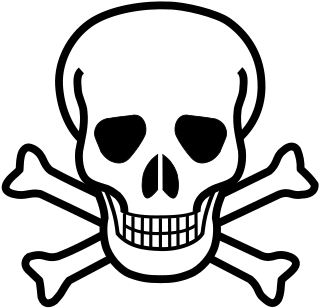Related Research Articles

The Mohs scale of mineral hardness is a qualitative ordinal scale, from 1 to 10, characterizing scratch resistance of various minerals through the ability of harder material to scratch softer material.

Toxicity is the degree to which a chemical substance or a particular mixture of substances can damage an organism. Toxicity can refer to the effect on a whole organism, such as an animal, bacterium, or plant, as well as the effect on a substructure of the organism, such as a cell (cytotoxicity) or an organ such as the liver (hepatotoxicity). By extension, the word may be metaphorically used to describe toxic effects on larger and more complex groups, such as the family unit or society at large. Sometimes the word is more or less synonymous with poisoning in everyday usage.

A blood test is a laboratory analysis performed on a blood sample that is usually extracted from a vein in the arm using a hypodermic needle, or via fingerprick. Multiple tests for specific blood components, such as a glucose test or a cholesterol test, are often grouped together into one test panel called a blood panel or blood work. Blood tests are often used in health care to determine physiological and biochemical states, such as disease, mineral content, pharmaceutical drug effectiveness, and organ function. Typical clinical blood panels include a basic metabolic panel or a complete blood count. Blood tests are also used in drug tests to detect drug abuse.

An automated analyser is a medical laboratory instrument designed to measure different chemicals and other characteristics in a number of biological samples quickly, with minimal human assistance. These measured properties of blood and other fluids may be useful in the diagnosis of disease.

Spectrophotometry is a branch of electromagnetic spectroscopy concerned with the quantitative measurement of the reflection or transmission properties of a material as a function of wavelength. Spectrophotometry uses photometers, known as spectrophotometers, that can measure the intensity of a light beam at different wavelengths. Although spectrophotometry is most commonly applied to ultraviolet, visible, and infrared radiation, modern spectrophotometers can interrogate wide swaths of the electromagnetic spectrum, including x-ray, ultraviolet, visible, infrared, and/or microwave wavelengths.

Clinical urine tests are examinations of the physical and chemical properties of urine and its microscopic appearance to aid in medical diagnosis. The term urinalysis—a portmanteau of the words urine and analysis—generally refers to the gross (macroscopic) examination of the urine, chemical evaluation using urine test strips, and microscopic examination. Macroscopic examination targets parameters that can be measured with the naked eye, including volume, color, transparency, odor, and specific gravity; urine test strips measure chemical properties such as pH, glucose concentration, and protein levels; and light microscopy is performed to identify elements such as cells, urinary casts, crystals, and organisms. Other analyses routinely performed on urine samples include urine electrolyte levels, drug testing, pregnancy testing and microbiological culture.

Assessment of kidney function occurs in different ways, using the presence of symptoms and signs, as well as measurements using urine tests, blood tests, and medical imaging.

Environmental chemistry is the scientific study of the chemical and biochemical phenomena that occur in natural places. It should not be confused with green chemistry, which seeks to reduce potential pollution at its source. It can be defined as the study of the sources, reactions, transport, effects, and fates of chemical species in the air, soil, and water environments; and the effect of human activity and biological activity on these. Environmental chemistry is an interdisciplinary science that includes atmospheric, aquatic and soil chemistry, as well as heavily relying on analytical chemistry and being related to environmental and other areas of science.

Generally recognized as safe (GRAS) is a United States Food and Drug Administration (FDA) designation that a chemical or substance added to food is considered safe by experts under the conditions of its intended use. An ingredient with a GRAS designation is exempted from the usual Federal Food, Drug, and Cosmetic Act (FFDCA) food additive tolerance requirements. The concept of food additives being "generally recognized as safe" was first described in the Food Additives Amendment of 1958, and all additives introduced after this time had to be evaluated by new standards. The FDA list of GRAS notices is updated approximately each month, as of 2021.

Registration, Evaluation, Authorisation and Restriction of Chemicals (REACH) is a European Union regulation dating from 18 December 2006. REACH addresses the production and use of chemical substances, and their potential impacts on both human health and the environment. Its 849 pages took seven years to pass, and it has been described as the most complex legislation in the Union's history and the most important in 20 years. It is the strictest law to date regulating chemical substances and will affect industries throughout the world. REACH entered into force on 1 June 2007, with a phased implementation over the next decade. The regulation also established the European Chemicals Agency, which manages the technical, scientific and administrative aspects of REACH.
The limit of detection is the lowest signal, or the lowest corresponding quantity to be determined from the signal, that can be observed with a sufficient degree of confidence or statistical significance. However, the exact threshold used to decide when a signal significantly emerges above the continuously fluctuating background noise remains arbitrary and is a matter of policy and often of debate among scientists, statisticians and regulators depending on the stakes in different fields.
Logical Observation Identifiers Names and Codes (LOINC) is a database and universal standard for identifying medical laboratory observations. First developed in 1994, it was created and is maintained by the Regenstrief Institute, a US nonprofit medical research organization. LOINC was created in response to the demand for an electronic database for clinical care and management and is publicly available at no cost.

Wet chemistry is a form of analytical chemistry that uses classical methods such as observation to analyze materials. It is called wet chemistry since most analyzing is done in the liquid phase. Wet chemistry is also called bench chemistry since many tests are performed at lab benches.
An agent study is a part of a clinical trial that tests the chemotherapeutic properties of a specific substance. More specifically, an agent study is used to detect whether or not a substance can prevent or inhibit cancer. In a clinical trial, researchers perform multiple studies in order to test the potential of new cancer drugs. An agent study helps determine the potential of a substance to inhibit cancer, before more studies are done in order to further knowledge of this potential.
The Institute for Occupational Safety and Health of the German Social Accident Insurance is a German institute located in Sankt Augustin near Bonn and is a main department of the German Social Accident Insurance. Belonging to the Statutory Accident Insurance means that IFA is a non-profit institution.
A glossary of terms used in clinical research.
Yeast estrogen screen (YES) and Yeast androgen screen (YAS) are in vitro screens that have been developed in order to detect estrogenic and androgenic activities, respectively, of natural and synthetic compounds, mixtures and environmental samples.
Post-mortem chemistry, also called necrochemistry or death chemistry, is a subdiscipline of chemistry in which the chemical structures, reactions, processes and parameters of a dead organism is investigated. Post-mortem chemistry plays a significant role in forensic pathology. Biochemical analyses of vitreous humor, cerebrospinal fluid, blood and urine is important in determining the cause of death or in elucidating forensic cases.

A bioassay is an analytical method to determine the concentration or potency of a substance by its effect on living animals or plants, or on living cells or tissues(in vitro). A bioassay can be either quantal or quantitative, direct or indirect. If the measured response is binary, the assay is quantal, if not, it is quantitative.
General Tests of English Language Proficiency (G-TELP) are English language tests, developed by the International Testing Services Center (ITSC) in 1985. They comprehensively evaluate the practical English use ability of test takers who do not speak English as their native language.
References
- ↑ Thomas Falen; Alice Noblin; Brandy Ziesemer (1 December 2010). Learning to Code with CPT/HCPCS 2011. Lippincott Williams & Wilkins. pp. 114–. ISBN 978-0-7817-8120-6 . Retrieved 13 July 2011.